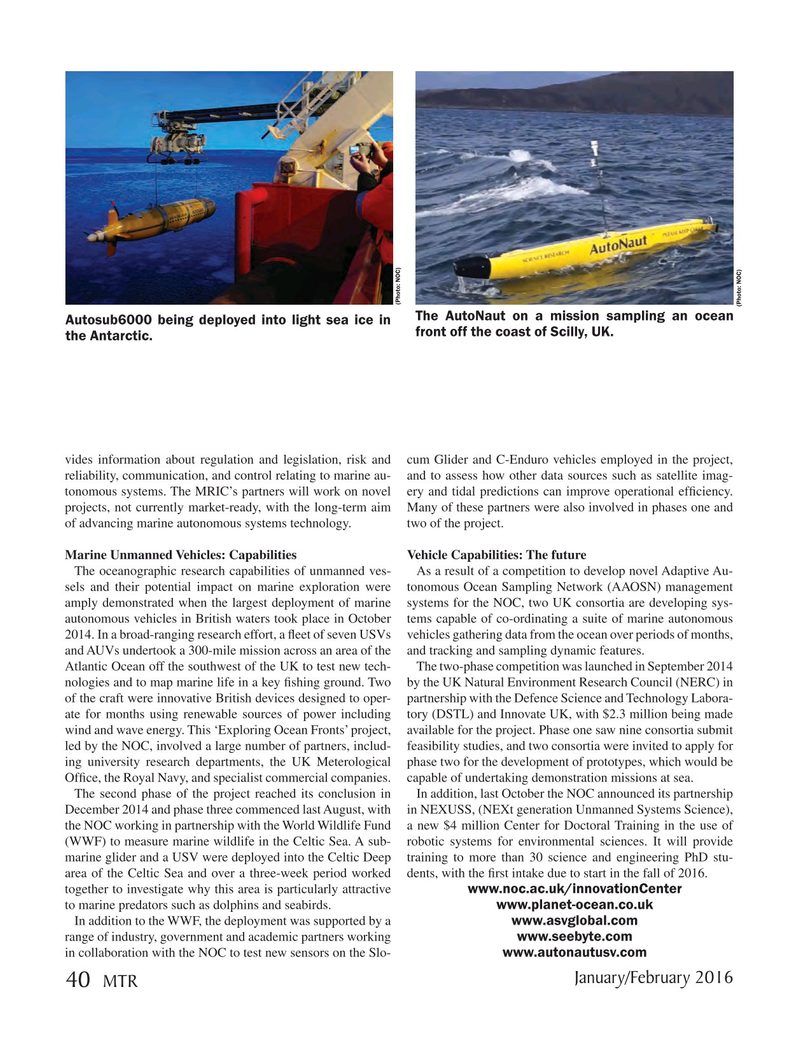
Page 40: of Marine Technology Magazine (January 2016)
Underwater Vehicle Annual: ROV, AUV, and UUVs
Read this page in Pdf, Flash or Html5 edition of January 2016 Marine Technology Magazine
(Photo: NOC) (Photo: NOC)
The AutoNaut on a mission sampling an ocean
Autosub6000 being deployed into light sea ice in front off the coast of Scilly, UK.
the Antarctic.
vides information about regulation and legislation, risk and cum Glider and C-Enduro vehicles employed in the project, reliability, communication, and control relating to marine au- and to assess how other data sources such as satellite imag- tonomous systems. The MRIC’s partners will work on novel ery and tidal predictions can improve operational ef? ciency. projects, not currently market-ready, with the long-term aim Many of these partners were also involved in phases one and of advancing marine autonomous systems technology. two of the project.
Marine Unmanned Vehicles: Capabilities Vehicle Capabilities: The future
The oceanographic research capabilities of unmanned ves- As a result of a competition to develop novel Adaptive Au- sels and their potential impact on marine exploration were tonomous Ocean Sampling Network (AAOSN) management amply demonstrated when the largest deployment of marine systems for the NOC, two UK consortia are developing sys- autonomous vehicles in British waters took place in October tems capable of co-ordinating a suite of marine autonomous 2014. In a broad-ranging research effort, a ? eet of seven USVs vehicles gathering data from the ocean over periods of months, and AUVs undertook a 300-mile mission across an area of the and tracking and sampling dynamic features.
Atlantic Ocean off the southwest of the UK to test new tech- The two-phase competition was launched in September 2014 nologies and to map marine life in a key ? shing ground. Two by the UK Natural Environment Research Council (NERC) in of the craft were innovative British devices designed to oper- partnership with the Defence Science and Technology Labora- ate for months using renewable sources of power including tory (DSTL) and Innovate UK, with $2.3 million being made wind and wave energy. This ‘Exploring Ocean Fronts’ project, available for the project. Phase one saw nine consortia submit led by the NOC, involved a large number of partners, includ- feasibility studies, and two consortia were invited to apply for ing university research departments, the UK Meterological phase two for the development of prototypes, which would be
Of? ce, the Royal Navy, and specialist commercial companies. capable of undertaking demonstration missions at sea.
The second phase of the project reached its conclusion in In addition, last October the NOC announced its partnership
December 2014 and phase three commenced last August, with in NEXUSS, (NEXt generation Unmanned Systems Science), the NOC working in partnership with the World Wildlife Fund a new $4 million Center for Doctoral Training in the use of (WWF) to measure marine wildlife in the Celtic Sea. A sub- robotic systems for environmental sciences. It will provide marine glider and a USV were deployed into the Celtic Deep training to more than 30 science and engineering PhD stu- area of the Celtic Sea and over a three-week period worked dents, with the ? rst intake due to start in the fall of 2016.
together to investigate why this area is particularly attractive www.noc.ac.uk/innovationCenter to marine predators such as dolphins and seabirds.
www.planet-ocean.co.uk
In addition to the WWF, the deployment was supported by a www.asvglobal.com range of industry, government and academic partners working www.seebyte.com in collaboration with the NOC to test new sensors on the Slo- www.autonautusv.com
January/February 2016 40
MTR
MTR #1 (34-49).indd 40 1/21/2016 2:14:45 PM

 39
39

 41
41
